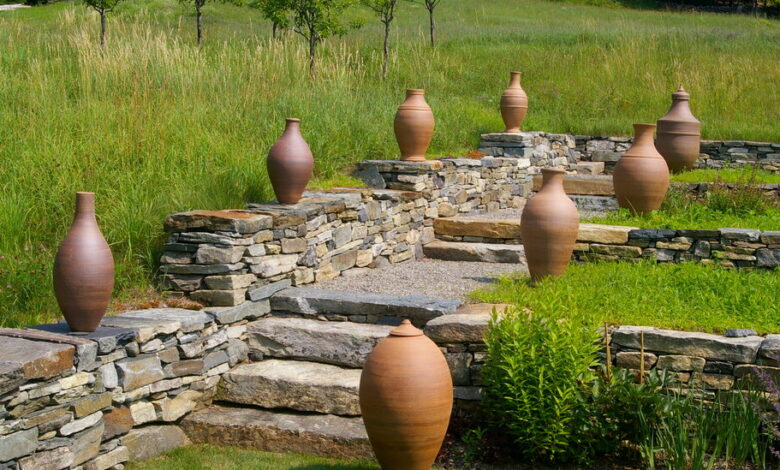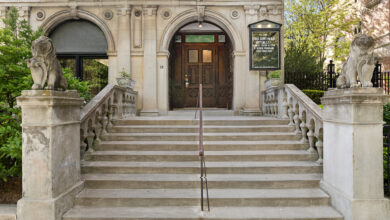How to Elevate Your Garden With Ceramics (And Not Just Flower Pots)

[ad_1]
Flower pots, they are not. But Stephen Procter’s large stoneware garden vessels, some as tall as five feet and incorporating 250 pounds of clay, are nevertheless functional pottery — even without the soil and the plants.
In the clay world, he said, there’s always talk about functional versus nonfunctional pottery, attempting to draw a line between the two. Mr. Procter, a Vermont-based ceramist, has seen his and other such outsize garden sculptures in action, though.
“An object that invites contemplation, and inspires, and offers this kind of mysterious sustenance is functional in a deep and important way,” he said. “Not functional that you’re going to drink your coffee out of it, but the work has high purpose in the landscape and in the world.”
A substantial sculptural element can perform a variety of garden-design jobs, he added, strengthening the structure of the landscape by “calling attention to its junctures — the entry, or the transition point, or the destination.”
Mr. Procter has watched the space-transforming powers of ceramics at work for roughly 20 years, since his first installation in a client’s garden, and observed the audience reaction at outdoor shows of his work at public gardens like Blithewold, in Rhode Island, and the Mount, Edith Wharton’s home in the Berkshires of Massachusetts.
It’s like the Wallace Stevens poem “Anecdote of the Jar,” he said, which tells of a round jar placed on a hill in Tennessee, and what happens to the scene in response.
“The wilderness rose up to it,” the poet wrote. “And sprawled around, no longer wild.”
Inspirations From Seed Pods, Hives, Cocoons
The lesson for gardeners: An imposing piece of pottery can be pivotal to the design of a landscape — as much so as any well-placed plant. Maybe even more so, if it is winter-hardy like one of Mr. Procter’s high-fired clay vessels, which are persistent garden performers in every season.
To his eye, pieces with an organic shape fill this role this especially well. He describes his shape aesthetic as “an amalgamation of classic Mediterranean pot vernacular and forms inspired by nature: seed pod, hive, cocoon.”
It is the pots’ shape and scale that do the job. He leaves the surfaces simple, without colorful glazes or decoration.
“I find that decoration tends to narrow what the pot can be to somebody,” Mr. Procter said. “It specifies it in a style, or specifies it in an era or a culture, and I’m much more interested in the sort of Rorschach inkblot, an object that somebody can take wherever they want it to go.”
The vessels possess an “animate presence,” he said, that clients and their garden visitors interact with intimately, by touching them and even speaking or singing to them.
“They approach them as if they’re friendly ponies,” he said. “They’ll stroke them, they’ll hug them, and they’ll always peer into them.”
For one couple whose garden is home to a creation of Mr. Procter’s, that life force feels so strong, they refer to the pot with a personal pronoun.
“She brings a breathing focal point that both grounds the garden and merges it with the surrounding woods and mountain,” Ingrid and Jim Miller, of Dublin, N.H., wrote in an email to Mr. Procter.
Like Writing Music, but in Clay
Unlike a figurative sculpture, an organically shaped one “is not calling attention to itself, it’s harmonizing,” said Mr. Procter, using a word from an earlier career in music.
After earning a master’s degree in classical guitar, he worked as a professional musician. It wasn’t until he was in his mid-30s, he said, that he “stumbled into clay.” The youngest of his three children was enrolled in a pottery class, and he recalls watching her at the wheel.
“I got very intrigued, as much by the magic of turning this inert lump of earth into something that embodied intelligence as by the meditation bubble that forms around someone who’s working intently on the potter’s wheel,” he said. “It’s centering on many levels.”
That inspired him to take classes at a community clay studio. Unlike most of the other students, he wanted to explore large vessels, which felt like “mysterious beings of a sort,” he said. (No surprise that he has since been told he used more clay than anyone else in decades of students in that beginner class.)
These days, at 68, he is a teacher, offering classes and weekend workshops to those who wish to try making the large-scale vessels that are his signature.
Maybe the best compliment he has received came from a friend who knew him during his music years. “These look like crystallized music,” the person told him.
Indeed, Mr. Procter said, “all the same elements are at play in interpreting or writing a piece of music as in making the pots. You’re looking at harmony and contrast, and balance and flow, rhythm and articulation.”
He added: “The transition from music to clay was strangely seamless. I felt like this was just a visual analog of what I’d been doing in sound and time, now doing in space and material.”
Garden Roles for a Sculptural Element
There are a number of roles that such sculptural elements can play in the garden. Sometimes, when two pots are placed in a garden space, a duet begins — even when one of them isn’t of heroic proportions.
“There can be a much smaller pot at quite a distance that would feel lost by itself, but it somehow belongs to that bigger pot,” Mr. Procter said. “And people draw very strong imaginary lines between the vessels. The mind and eye want to connect them.”
Elsewhere, a large vessel may create a center point from which other elements in the garden will then seem to radiate. As in the Wallace Stevens poem, Mr. Procter said, it’s as if “the pot reorganizes everything around it.”
When used to mark a transition between garden areas, he said, the vessels “become a greeter, if you will, to this new part of the garden that you’re moving to,” or they mark a turn or bifurcation in a path.
“When placed carefully,” Michael Gordon, a garden designer in Peterborough, N.H., told Mr. Procter, the vessels “bring a feeling of both surprise and serenity to the journey down a garden path.”
A few clients have used one of his pots in a manner that has fascinated him: placed next to a very large rock. “It somehow tames the rock,” he said. “It doesn’t diminish it in some way, but it adds this other element and starts a conversation between the wild and the made that I find mysterious and interesting.”
Some outdoor sculptural elements can beckon loudly from a distance — when a formal pot is shown off in a formally designed garden, for example, perhaps set upon a plinth. But Mr. Procter is often happier when the lines are a little fuzzier.
“A pot that’s more organic and wild sometimes is more alluring when it’s partially obscured by foliage, and it creates this intrigue: ‘What is that? What’s the rest of it? How do I understand it?’” he said. “And that can be, in some ways, a more compelling and alluring kind of draw than the one that reveals itself all at once.”
As Bess Haire and Chris Gunner, of Jaffrey, N.H., wrote in an email to Mr. Procter, “More than just ornament, the pots are to us barometer, mirror, company and sentinel.”
Into the Kiln, and Into the Garden
Like the making of a garden, the creation of a large vessel cannot be rushed. From start to finish, the process takes about three weeks.
“The pots that get built faster, they’re just not as good,” Mr. Procter said. “There’s some benefit in standing back, stepping away, letting the idea settle a little bit more, coming back and revisiting it, and working on it incrementally.”
Even after so many years, he acknowledges, it sometimes seems like a preposterous undertaking.
After as much as a week of hands-on building time, he lets the work air-dry for maybe another week before it is ready to be fired.
Just watching Mr. Procter’s assistant load the kiln in a recent Instagram reel is enough to make a viewer anxious. They are helped by a gantry crane — as an automotive shop might hoist an engine — and the floor of the kiln rolls out to meet the incoming vessel. After a couple of days of gradual preheating, the piece inside the six-by-six-foot box atop a brick foundation is fired to 2,340 degrees in a 14-hour cycle. Then it cools slowly over two days.
A lid is fired for each pot, for use in winter to keep out moisture that could thaw and refreeze inside, causing damage.
But the rest of the year, it’s lids off — or at least that’s Mr. Procter’s preference.
“It feels like they’re breathing the same air as the trees and the plants, and they’re participating,” he said. “When the lid goes on, they somehow feel more introspective and gestational.”
Margaret Roach is the creator of the website and podcast A Way to Garden, and a book of the same name.
If you have a gardening question, email it to Margaret Roach at [email protected], and she may address it in a future column.
[ad_2]
Source link






